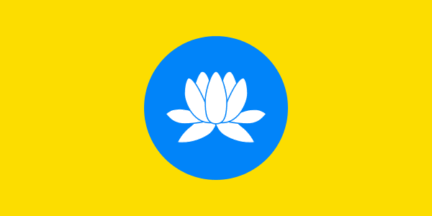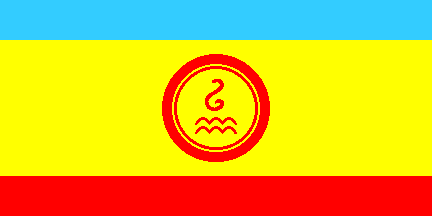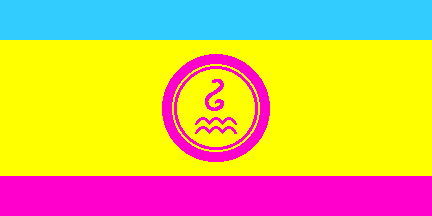 image by Tomislav Šipek, 13 December 2019
image by Tomislav Šipek, 13 December 2019
Last modified: 2021-12-31 by valentin poposki
Keywords: kalmykia | qalhmg tan̩q̣ĉ | buddhism | om | pink | flower | lotus | nine | error | law | derben oirat | oirat | error | erdneeva (b. b.) |
Links: FOTW homepage |
search |
disclaimer and copyright |
write us |
mirrors
 image by Tomislav Šipek, 13 December 2019
image by Tomislav Šipek, 13 December 2019(Note: You need an Unicode-aware software and font to correctely view the cyrillic text on this page. See here transliteration details).
Kalmyks, Mongol people of Oirot language, are of Buddhist religion.
Torgut, Dorbet and Buzawa tribes live in the republic. (Sart Kalmyks of
Kyrgyzstan are Muslim.) Kalmyks migrated to Caspian
region in the XVII th Century from Central Asia (nomadic cattle breeders).
Presently, Kalmykia is a constituent Republic of Russian Federation with a
fascinating personality as its president.
Chris Kretowicz, 06 Jun 2001
The Kalmyks settled the Volga River region in the seventeenth
century. A Mongol people, they were originally Buddhist in faith.
Annexed to Russia in 1771.
Stuart Notholt, 17 Sep 1995
Kalmyk people are the last Western Mongols,
the only Buddhist people in Europe.
Giuseppe Bottasini
Kalmylkia is a remnant state of the Mongol
Khans, and retains as a major religious force,
Buddhism.
Bruce C. Ward, 16 Apr 1997
I have an interesting photograph. It shows the Kalmyk minister of
culture presenting a Kalmyk flag to the Mayor of
Howell (New Jersey, US). The flag is fully
stretched out in front of them. Howell and
Elista (the capital of Kalmykia) participate in a sister cities
program. Many of the Kalmyk people who fled Russia in 1917 to
Yugoslavia and France, wound up in a displaced persons camp in Germany
after WWII. In 1952 they came to the US where most of them settled in
Howell. I am told that Howell now has the largest concentration of
Kalmyk people in the western hemisphere.
Dave Sanderson, 07 Apr 1997
The golden yellow is consistent with our faith. Yellow hat tradition
of the Gelunpa sect. The circle is the traditional learning tool of all
Mongol children. We are not people of square or linear reality.
Our shelter is round as the world, when we sit on the steppes and
look around us at the world in a circle.
Erdne Dorje, 22 Jun 1998
The Lotus Flower has significant symbolic
meaning to many Buddhists, especially those away from southern and
southwestern asia. By several sects, including mine, the Lotus Sutra is the
highest of Buddhist teachings. The lotus grows out of the silt, mud and
muck of the earth, and yet blossoms with great beauty — just as the nature
of one’s potential Buddhahood exists even in the heart of the most evil of
men.
Bruce C Ward, 16 Apr 1997
The flag of the Republic of Kalmykia was adopted 30 July 1993. In the flag regulations which were issued 8 February 1994 the flag is described as follows (Source: Government of the Republic of Kalmykia):
Regulations of the National flag of the Republic of Kalmykia — Khalmg TangchThis second post soviet flag was designed by B. B. Erdneeva. She also drew the coat of arms, which was adopted the same day as the flag.
- The National flag of the Republic of Kalmykia — Khalmg Tangch — Ulan zalata khalmg is a rectangular panel of golden-yellow, in the middle of which is a sky-blue circle with a white lotus consisting of nine petals.
The flag is attached to a pole crowned with a red tip in the form of a "tongue of flame" with contour outlines of the ancient symbol of Derben-Oirats — four circles clamped together, in the base of which there is "ulan zala". The ratio of the flag width to its length is 1:2. The ratio of the radius of the circle to the flag width is 1:3,5. The ratio of the distance from tip to tip of the flower to the flag width is 1:4.,.
I have a Law or Regulation "Concerning the Symbols of the Republic of
Kakmykia" dated 11 June (I think) 1996 in Russian.
Christopher Southworth, 15 Jun 2004
 image by Tomislav Šipek, 13 December 2019
image by Tomislav Šipek, 13 December 2019
 image by Željko Heimer, 11 Apr 1997
image by Željko Heimer, 11 Apr 1997
The first post soviet flag of Kalmykia was adopted by law of 30 October 1992. (Source: Government of the Republic of Kalmykia)
Article 158: The National flag of the Republic of Kalmykia — Khalmg Tangch is a rectangular panel consisting of three horizontal stripes: the upper one is sky-blue, the middle one is golden-yellow and the lower one is scarlet. In the centre of the golden-yellow stripe, in a circle having a diameter equal to 1/4 of the flag width, is a sign in the form of flame of fire over the two wavy lines. The sign and the circumference are scarlet. The ratio of the width of the stripes of light blue and scarlet to the width of the golden-yellow stripe is 1:2. The ratio of the flag width to its length is 1:2.Jos Poels 16 May 1996
Scarlet was the Soviet
Flag. It was never shown in pink, as this is a
Russian alternate description for red.
Ralf Stelter, 27 Jun 1999
 image by Željko Heimer, 11 Apr 1997
image by Željko Heimer, 11 Apr 1997
This flag is listed under number 93 at the chart Flags
of Aspirant Peoples [eba94] as: Khalmg-Tangch (Kalmyks)
- South-East European Russia.
Ivan Sache, 15 Sep 1999